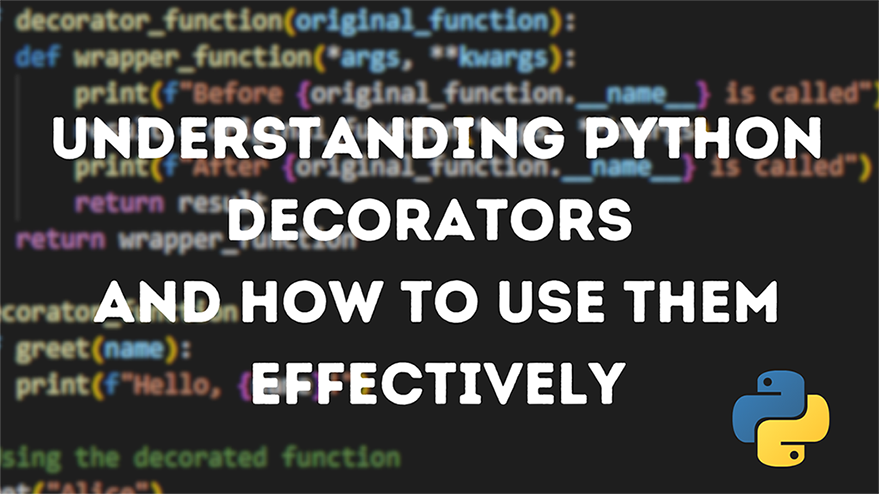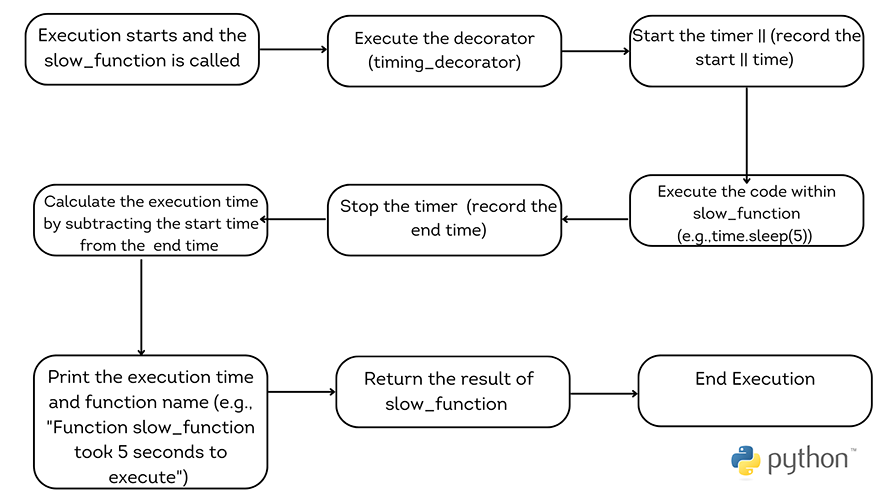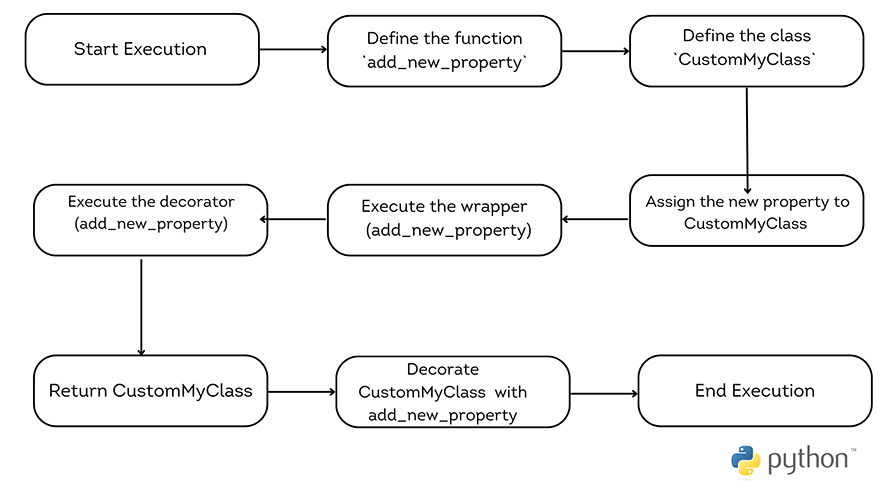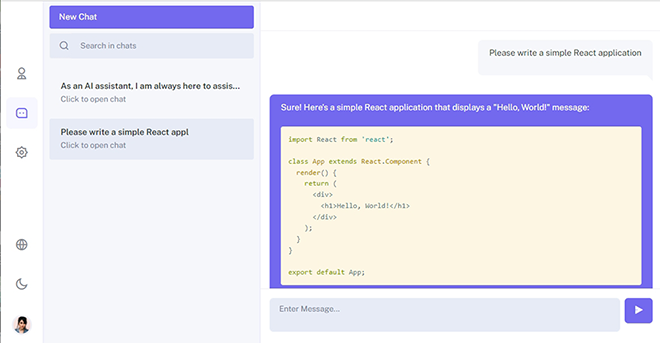Understanding Python Decorators and How to Use Them Effectively

Understanding Python Decorators and How to Use Them Effectively
As a developer who is constantly exploring new ways to improve code readability and maintainability, I find Python decorators to be an incredibly powerful tool. They enable us to extend the functionality of functions and methods elegantly, without altering their code. In my opinion, mastering decorators is a must for any Python programmer who wants to take their coding skills to the next level and contribute to more efficient and cleaner codebases.
Python decorators are a super handy and flexible aspect of the language, and I think that getting the hang of them is crucial for any Python programmer. Decorators let you adjust the behavior of functions or classes while they’re running, all without messing with their original code. This means you can add, subtract, or change the capabilities of existing code without directly interacting with it, which is pretty awesome.
In this piece, I’ll provide you with a thorough and engaging guide on Python decorators. We’ll cover the basics of function and class decorators, figure out how to develop custom decorators, investigate chaining and nesting decorators, and look at real-world examples of decorator usage. On top of that, we’ll chat about some advanced applications and best practices for decorators. So, get cozy, grab your go-to drink, and let’s plunge into the fascinating realm of Python decorators!
What are Decorators?
In a nutshell, a decorator is a function that takes another function or class as input and gives back a new function or class, typically with some extra features. Basically, decorators let you tweak the behavior of functions or classes in a neat and effective manner.
Decorators hold a significant place in Python programming, as they help you craft more modular, manageable, and reusable code. By employing decorators, you can divide responsibilities, leading to tidier and more compact code. Plus, decorators let you adeptly handle cross-cutting concerns such as logging, caching, error management, and security.
Importance of Decorators
Here are some key reasons why decorators are essential in Python:
- Code Reusability: Decorators enable you to use the same code in multiple places without copying and pasting. This makes your code more modular, easier to maintain, and less prone to errors. Decorators help to keep your code DRY (Don’t Repeat Yourself) and promote reusability.
- Separation of Concerns: By using decorators, you can separate your code’s concerns and ensure that each part of your program focuses on its specific task. This makes your code more comprehensible and easier to modify.
- DRY (Don’t Repeat Yourself) Principle: Decorators help you avoid repeating code in various places. Instead, define a decorator once and use it wherever necessary. This makes your code more efficient and maintainable.
- Clean Code: Decorators help you write cleaner, more readable code. By using decorators, you can eliminate boilerplate code and make your code more concise, which is always a good thing.
- Extensibility: Decorators offer an easy way to extend existing code’s behavior. You can use decorators to add new functionality to a function or class without changing its original source code, allowing for more flexible and adaptable code.
Types of Decorators in Python
There are four primary types of decorators in Python:
- Function Decorators: These let you tweak a function’s behavior by covering it with another function. This way, you can change how a function works without messing with its original code.
- Class Decorators: These wrap a class with another one, allowing you to alter the class’s behavior, add features, or even change how its instances are made.
- Method Decorators: With these, you can modify a class method’s behavior by enveloping it with another function. This comes in handy when you want to add extra functionality to certain methods in a class without touching their original code.
- Parameterized Decorators: These are decorators that take arguments. You create them by defining a function that returns a decorator. They are beneficial due to their ability to accept parameters, which enhances their adaptability and potency
This article will focus on function decorators and class decorators, providing you with practical examples, explanations, and even some tips and tricks to help you become proficient in using decorators in your Python projects
Function Decorators
Function decorators are a super neat and potent feature in Python. They allow you to accept one function as input, tweak its behavior, and give back a new function. Usually, you’ll employ function decorators to introduce extra features to a function, like logging, caching, or error management.
For example, let’s say you have a function that says “Hello”. You want to add some extra behavior to it, like printing a message before and after it executes.
Instead of changing the code of the original function, you can create a decorator function that takes the original function as input, and returns a new function that adds the extra behavior. You then apply the decorator to the original function using the @ symbol.
In Python, making a function decorator is as simple as using the ‘@’ symbol followed by the decorator function’s name. Take a look at this example:
1 2 3 4 5 6 7 8 9 10 11 12 | def my_decorator(func): def wrapper(): print("Something is happening before the function is called.") func() print("Something is happening after the function is called.") return wrapper @my_decorator def say_hello(): print("Hello!") say_hello() |
In this example, the my_decorator function is a decorator that takes a function func as input, creates a new function wrapper that adds some behavior before and after func is called, and returns that new function.
The @my_decorator syntax is used to apply the decorator to the say_hello function, effectively replacing say_hello with the wrapper function that is returned by my_decorator. When say_hello is called, it now executes the wrapper function, which prints some text before and after calling the original say_hello function.
Here’s a visual representation of how this decorator code snippet executes:

Schematic diagram representing how the function decorator example executes
How to Create Function Decorators
Want to make your own custom function decorator? No problem! Just define a function that takes another function as input, modifies its behavior, and returns a new function. Here’s an example of a custom function decorator that times the execution of a function:
1 2 3 4 5 6 7 8 9 10 11 12 13 14 15 16 17 18 19 | import time def timing_decorator(func): def wrapped_function(*args, **kwargs): start_time = time.time() result = func(*args, **kwargs) end_time = time.time() print(f"Function {func.__name__} took {end_time - start_time} seconds to execute") return result return wrapped_function @timing_decorator def slow_function(): time.sleep(5) slow_function_example() # Output # Function slow_function_example took 5.001524925231934 seconds to execute |
In the code snippet above, the timing_decorator defines a function called wrapper_function that measures the time it takes to execute the original function and prints a message with the execution time in seconds. The wrapper_function then returns the result of the original function.
The @timing_decorator syntax is used to apply the decorator to the slow_function function. When slow_function is called, it is actually replaced by the wrapper function defined by the decorator, which then executes the original slow_function code and prints a message with the execution time.
Common Use Cases of Function Decorators
Function decorators are super handy for cross-cutting concerns like logging, caching, error handling, and authentication. They’re also great for adding timing or profiling to functions, validating function arguments, or transforming function output.
Class Decorators
Class decorators, like function decorators, are a powerful feature in Python. However, instead of modifying functions, class decorators are applied to classes. They can be used to change a class’s behavior, add new methods, or add new properties.
The syntax for a class decorator is similar to that of a function decorator, but it is applied to a class. Here’s an example of a class decorator in Python:
1 2 3 4 5 6 7 8 9 10 11 12 13 14 15 16 17 18 19 20 21 | def my_decorator(cls): class NewClass: def __init__(self, *args, **kwargs): self.obj = cls(*args, **kwargs) def new_method(self): print("This is a new method added by the decorator.") return NewClass @my_decorator class MyClass: def __init__(self, value): self.value = value def say_hello(self): print(f"Hello, my value is {self.value}.") my_object = MyClass("world") my_object.say_hello() my_object.new_method() |
In this example, the my_decorator function is a decorator that takes a class cls as input, creates a new class NewClass that adds some extra behavior, and returns that new class.
The @my_decorator syntax is used to apply the decorator to the MyClass class, effectively replacing MyClass with the NewClass class that is returned by my_decorator. When you create an object of MyClass (which is now actually an object of NewClass), it now has a new method called new_method that was added by the decorator, in addition to the original say_hello method.
When you call the say_hello method, it executes the original code of the MyClass method. When you call the new_method method, it executes the code added by the decorator.
Here’s a schematic diagram on how this decorator snippet executes:

Schematic diagram representing how the function decorator example executes
How to Create Class Decorators
Creating class decorators is similar to creating function decorators. You define a function that takes a class as an argument, modifies the class in some way, and then returns the modified class. Here’s an example of a class decorator that adds a new property to a class:
1 2 3 4 5 6 7 | def unique_add_property(unique_cls): unique_cls.unique_new_property = "This is a new property" return unique_cls @unique_add_property class UniqueMyClass: unique_existing_property = "This is an existing property" |
This code defines a Python class decorator called unique_add_property that adds a new class-level attribute to the decorated class. The decorator takes a class as input and returns the same class with the new attribute added.
The add_property decorator just adds a new attribute called new_property to the class. The @add_property syntax is used to apply the decorator to the MyClass class.
Common Use Cases of Class Decorators
Class decorators can be utilized in various ways. Some common use cases include:
- Adding new methods to a class
- Adding new properties to a class
- Modifying the behavior of a class
- Implementing class-level caching
- Implementing class-level memoization
For instance, a class decorator could be used to add a count attribute to all instances of a class to keep track of the number of instances created:
1 2 3 4 5 6 7 8 9 10 11 12 13 14 15 16 17 | def count_instances(cls): cls._count = 0 cls._old_init = cls.__init__ def new_init(self, *args, **kwargs): cls._count += 1 cls._old_init(self, *args, **kwargs) cls.__init__ = new_init return cls @count_instances class MyClass: def __init__(self, x): self.x = x a = MyClass(1) b = MyClass(2) print(MyClass._count) # prints 2 |
In this example, the count_instances decorator adds a _count attribute and a modified __init__ method to the class. The modified __init__ method increments the count whenever a new instance is created. The resulting class can be used normally, but with the added behavior defined by the decorator.
Decorator Chaining and Nesting
Decorator chaining and nesting are techniques used in Python to apply multiple decorators to a single function or class. Decorator chaining involves applying multiple decorators in sequence, where each decorator modifies the output of the previous decorator. Decorator nesting, on the other hand, involves applying a decorator to a function or class that has already been decorated with another decorator.
Decorator Chaining
Here is an example of decorator chaining:
1 2 3 4 5 | @decorator1 @decorator2 @decorator3 def my_function(): # function code |
In this example, my_function is decorated with three decorators in sequence: decorator1, decorator2, and decorator3. The output of decorator3 is passed as the input to decorator2, and so on.
Decorator Nesting
1 2 3 4 5 6 7 8 9 10 11 | @decorator1 @decorator2 def my_function(): # function code @decorator3 @decorator4 @decorator5 @my_function def my_decorated_function(): # function code |
In this example, my_function is being decorated with decorator1 and decorator2, while my_decorated_function is being decorated with decorator3, decorator4, decorator5, and my_function. The order in which the decorators are applied matters, since each decorator modifies the behavior of the function in turn.
When using decorator chaining and nesting, it is important to ensure that the decorators are applied in the correct order. Decorators that modify the behavior of a function should be applied first, followed by decorators that modify the output of the function. It is also a good practice to use clear and descriptive names for the decorators to make the code more readable.
Practical Examples of Decorator Applications
Memoization
Memoization is a technique used to optimize the performance of functions that are computationally expensive. It involves caching the results of a function so that the function does not have to be re-evaluated every time it is called with the same input. This can be implemented using a memoization decorator in Python.
1 2 3 4 5 6 7 8 9 10 11 12 13 14 15 16 17 18 19 20 | def memoize(func): cache = {} def wrapper(*args): if args in cache: return cache[args] else: result = func(*args) cache[args] = result return result return wrapper @memoize def fib(n): if n in (0, 1): return n return fib(n-1) + fib(n-2) print(fib(40)) # prints 102334155 |
This code defines a function memoize that takes a function func as input and returns a new function wrapper that caches the results of func for each set of arguments it is called with.
When wrapper is called with a set of arguments, it first checks if the result for those arguments is already in the cache dictionary. If it is, the cached result is returned. Otherwise, func is called with the arguments, and the result is stored in the cache dictionary before being returned.
The @memoize decorator is applied to the fib function, which calculates the n-th number in the Fibonacci sequence recursively. By caching the results of previous calls, the memoize decorator significantly speeds up the calculation of large Fibonacci numbers.
When the code is run and fib(40) is called, the cached results are used to avoid redundant calculations, and the correct result of 102334155 is printed to the console.
Timing and Profiling
Decorators can be used to time the execution of a function or to profile the function to identify performance bottlenecks. This can be useful for optimizing code and improving performance.
1 2 3 4 5 6 7 8 9 10 11 12 13 14 15 16 | import time def timer(func): def wrapper(*args, **kwargs): start_time = time.time() result = func(*args, **kwargs) end_time = time.time() print(f"Function {func.__name__} took {end_time - start_time:.6f} seconds to execute.") return result return wrapper @timer def my_function(): # function code my_function() |
In this example, the timer decorator is used to measure the execution time of my_function. The decorator captures the start time, calls the original function, and then calculates the elapsed time. The elapsed time is printed to the console, and the result of the function is returned.
Authorization and Authentication
Decorators can be used to implement authorization and authentication in web applications. For example, a decorator can be used to check if a user is logged in before allowing them to access certain pages.
1 2 3 4 5 6 7 8 9 10 11 12 13 14 15 16 17 18 19 20 21 22 23 24 25 26 | # Import necessary modules from flask import Flask, request, redirect, url_for, session # Create an instance of the Flask class with the name of the application as the argument app = Flask(__name__) # Define a function called login_required that takes in another function as an argument def login_required(func): # Define a nested function called wrapper that takes in any number of positional and keyword arguments def wrapper(*args, **kwargs): # Check if the 'username' key is present in the session if 'username' in session: # If it is present, call the original function with the positional and keyword arguments passed to the wrapper function return func(*args, **kwargs) else: # If it is not present, redirect the user to the login page with the 'next' parameter set to the current page URL return redirect(url_for('login', next=request.url)) # Return the wrapper function return wrapper # Define a route for the '/dashboard' page and decorate it with the login_required function @app.route('/dashboard') @login_required def dashboard(): # This code will only be executed if the user is logged in return "This is a protected page" |
This code is for a Flask web application that has a protected page called /dashboard. The login_required function is a decorator that checks if the user is logged in before allowing them to access the protected page. If the user is not logged in, they are redirected to the login page. The @app.route('/dashboard') line creates the /dashboard route and applies the login_required decorator to it, so that only logged-in users can access the page. When a logged-in user visits /dashboard, they will see the message “This is a protected page”.
Logging
Decorators can be used to implement logging in Python applications. This can be useful for debugging and monitoring the application’s behavior.
1 2 3 4 5 6 7 8 9 10 11 12 13 14 15 16 | import logging def log(func): logging.basicConfig(level=logging.DEBUG) def wrapper(*args, **kwargs): logging.debug(f"Function {func.__name__} called with args {args}, kwargs {kwargs}") return func(*args, **kwargs) return wrapper @log def my_function(): # function code my_function() |
This code is for a decorator log that logs the name of a function and its arguments whenever the function is called. The decorator is applied to the my_function function, which doesn’t take any arguments. When my_function() is called, a message is logged to the console with the function name and its arguments.
Error Handling
Decorators can be used to implement error handling in Python applications. This can be useful for handling exceptions in a consistent and structured way.
1 2 3 4 5 6 7 8 9 10 11 12 13 14 15 16 | def handle_error(func): def wrapper(*args, **kwargs): try: result = func(*args, **kwargs) except Exception as e: print(f"Error occurred in function {func.__name__}: {e}") result = None return result return wrapper @handle_error def my_function(): # function code my_function() |
This code defines a decorator handle_error that catches any exceptions that occur when a decorated function is called and prints a message with the function name and the exception message to the console. The @handle_error decorator is applied to the my_function function. When my_function() is called, the wrapper function defined in the handle_error decorator is called instead. If an exception occurs during the execution of my_function, an error message is printed to the console.
Conclusion
Decorators serve as a crucial aspect of Python programming, enabling programmers to alter the behavior of functions and classes without making changes to the original source code. They can be used for a wide variety of tasks, from optimizing performance to implementing error handling.
This article covered the basics of Python decorators, including their syntax and how to create custom decorators. It also covered advanced decorator topics such as decorator chaining and nesting, as well as practical examples of how decorators can be used for memoization, timing and profiling, authorization and authentication, logging, and error handling.
sources: python official documentation, program wiz, kine’s youtube












No comments yet